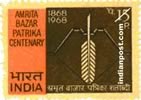| Postal Stamp Image |
: |
 |
| Stamp Issue Date |
: |
20/02/1968 |
| Postage Stamp Dinomination |
: |
0.15 |
| Postal Stamp Serial Number |
: |
0562 |
| Postal Stamp Name |
: |
SYMBOLIC BOW AND QUILL PEN |
| Stamp Information |
: |
AMRITA BAZAR PATRIKA CENTENARY
One hundred years ago, a great name in the journalistic annals of India came into existence. "Amrita Bazar Patrika" was launched on its illustrious, turbulent journey as a Bengali weekly on 20th February, 1968. Its early issues came out from a remote village in the district of Jessor (Now in East Pakistan). The "Patrika" was not started as a commercial proposition, but to serve as the mouthpiece of the travails and aspirations of a down-trodden people.
It was a time of growing unrest. Politically, the people of India hardly counted in the eyes of the alien rulers. Economically, India was nothing more than a market for the expanding industries of their home country. As a result, the indigenous trades languished for want of support. The rural masses became increasingly poorer. Even in agriculture, the ryots were not left alone, but were compelled to grow indigo for the benefit of a small group of foreign indigo-planters. All tis exploitation led to widespread discontent. Shishir Kumar Ghosh organised the peasants to protest against the tyranny of the indigo-planters and the antipathy of the Government. He and his brothers founded the "Patrika" as part of this movement.
Three years after its inception, the paper shifted its venue to Calcutta. As was to be expected, the authorities were not happy that this outspoken publication should function in their midst. At first, attempts were made to cajole the paper into adopting a softer line. It was then that Shishir Kumar Ghosh addressed his famous words to the Lt. Governor of Bengal: "Let there be at least one honest journalist in the country." This infuriant the Lt. overnor who threatened the paper with cviction from Calcutta. Some years later, the Vernacular Press Act was enacted with a view to gagging the Indian language papers. But this design was frustrated in the case of the "Patrika". Its very next issue came out in Enlish.
In 1891, the "Patrika" became a daily. Its subsequent history followed the course of India's struggle for independence. Beggining with a prosecution within the first few months of its existence, the paper faced many more proscecutionsand other repressive measures. Nevertheless, it displayed unswering devotion to the nationalist cause. This endeared it to the people who showed their gratitude by offering it their powerful patronage.
Today, "Amrita Bazar Patrika" is one of the foremost national dailies, a position which it owes as much to its pioneering founders as to the patriotic ferour of the Indian people. The Posts & Telegraphs Department is glad to recognise the services of this great Indian-owned newspaper by bringing out a commemorative postage stamp to mark its cenenary. |
| Philatelic Stamp Description |
: |
Designed and Printed by the Directorate of Advertising & Visula Publicity, Ministry of I. & B., Govt. of India, New Delhi for the Indian Posts and Telegraphs Department and printed at Kapur Printing Press, Delhi. |
| Stamp Currency |
: |
P |
| Stamp Type |
: |
COMMEMORATIVE |
| Stamp Language |
: |
English |
| Stamp Overall Size |
: |
3.34 x 2.46 cms |
| Postal Stamp Print Size |
: |
2.99 x 2.1 cms. |
| Number of Stamps Per Sheet |
: |
54 |
| Stamp Perforations |
: |
14 x 13,1/ |
| Postal Stamp Shape |
: |
Horizontal |
| Postage Stamp Paper |
: |
Unwatermarked paper |
| Indian Stamp Process |
: |
Photogravure |
| Number of stamps printed |
: |
20,00,000 |
| Stamp Printed At |
: |
India Security Press |
| Indian Stamp's Color |
: |
Sepia and Crimson |
|
|
